Best Acoustic
Guitar String
-
Overall: 9/10
-
Best Feature: Made with bronze material
-
TedScore™: 9/10
Best Electric
Guitar String
-
Overall: 9/10
-
Best Feature: Vintage reissue design for authentic sound and feel
-
TedScore™: 9/10
Best Bass
Guitar String
-
Overall: 9/10
-
Best Feature : Made of stainless steel for durability and tone
-
TedScore™: 9/10
Ever had a rocking jam session, and then bam! Your guitar string snaps? It’s a pain, but hey, it happens to the best of us!
In fact, it’s an unfortunate reality for guitar players of all levels. But the question remains: how often do guitar strings break?
Well, that’s what we’re here to find out!
In this article, we’ll explore the factors contributing to guitar string breakage and provide some helpful tips on prolonging your strings’ life.
So, grab your guitar, and let’s begin!
Understanding Guitar Strings
Types of Guitar Strings
There are a few different types of guitar strings, including electric, acoustic, bass, and even classical nylon strings.
Electric guitars typically have steel guitar strings, while acoustic guitar strings can be made of steel or nylon.
Classical guitar strings are usually made of nylon. On the other hand, bass guitar strings are usually made of either roundwound or flatwound steel.
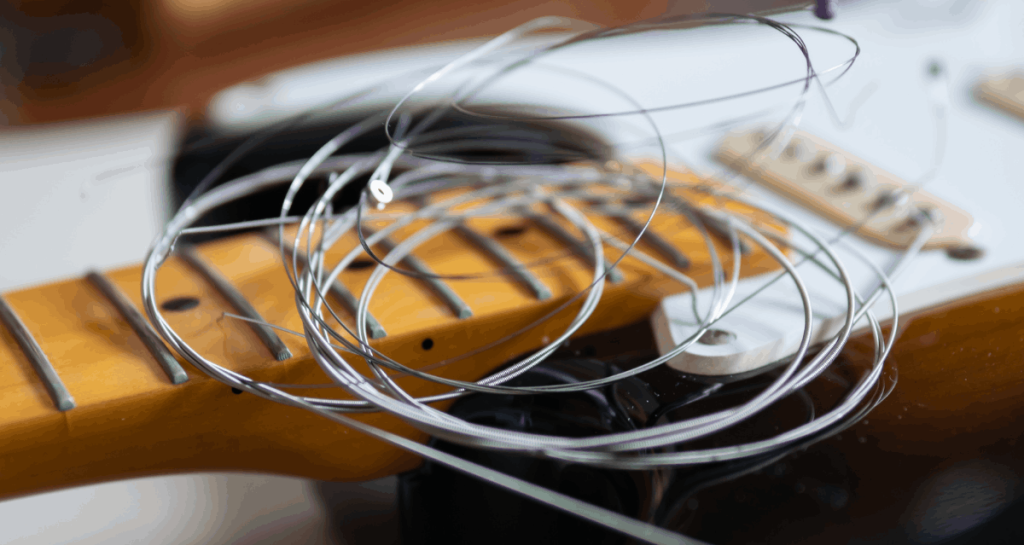
String Gauge
The gauge of a string refers to its thickness.
Typically, thicker strings tend to generate a more robust tone, whereas thinner acoustic strings tend to offer greater ease of playability.

Quality and Materials
The quality of a guitar string can vary greatly depending on the brand and the materials used.
Higher-quality strings are generally more expensive but tend to last longer and produce a better sound.
Some common materials used in guitar strings include nickel, bronze, and phosphor bronze.

Quality and Materials
Strings that have been coated are treated with a thin layer of material that serves to
Safeguard against corrosion and prolong their longevity.
While coated strings can be more expensive, they’re a good option for players who want to reduce the frequency of string changes.
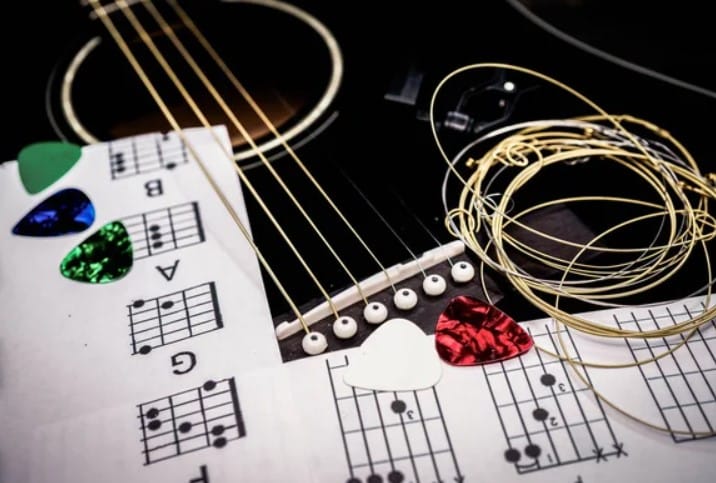
Wire and String Types
Few different types of wire are used in guitar strings, including roundwound, flatwound, and halfwound.
Roundwound strings have a brighter sound and are the most common type
while flatwound strings have a smoother sound and are often used in jazz music
Halfwound strings are a combination of the two.
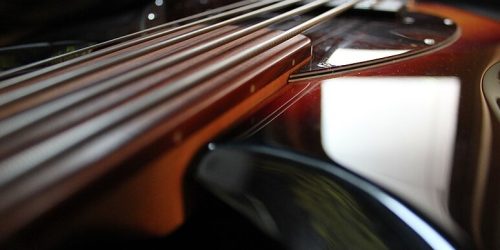
Is Breaking Guitar Strings Common?
Breaking guitar strings is a common occurrence, especially if you play frequently.
Strings are made from materials that are prone to wear and tear and are under constant tension when you play.
However, you can reduce the likelihood of string breakage with proper care and maintenance.

How Often Do Guitar Strings Break?
The frequency with which guitar strings break can vary depending on a number of factors, including how often you play, the type of guitar you have, and the quality of the strings.
Changing your strings every few months is a good idea to ensure that they’re in good condition and producing the best possible sound.
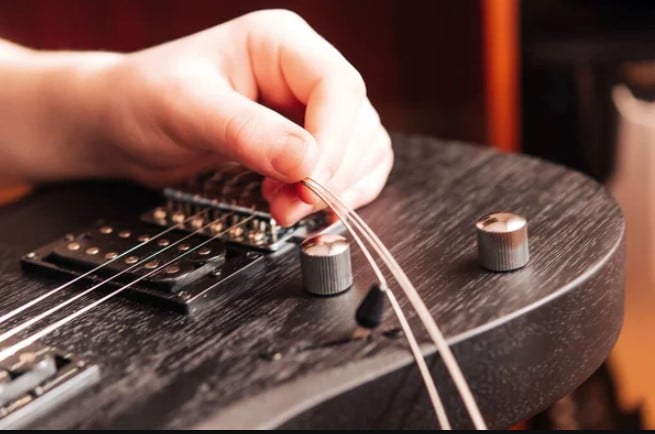
Why Guitar Strings Break Repeatedly
If you break guitar strings repeatedly, there may be a few reasons. One common cause is poor technique. If you’re playing too aggressively or using too much force, you may be putting too much stress on the strings, causing them to break.
Another cause could be the type of guitar strings you’re using. Different strings have different durability levels, so it’s important to choose the right ones for your playing style.
Other factors contributing to string breakage include dirt and grime buildup, rust and corrosion, and burred edges or grooves on the guitar’s hardware. Sweat, oils, humidity, and other environmental factors can also weaken the strings over time.

How Long Does it Take for Guitar Strings to Break?
The lifespan of a guitar string varies depending on a number of factors, including the type of string, how often you play, and how well you take care of it.
Generally, you can expect a set of strings to last anywhere from a few weeks to a few months.
However, it’s important to inspect your strings regularly for signs of wear and tear and to replace them as needed.
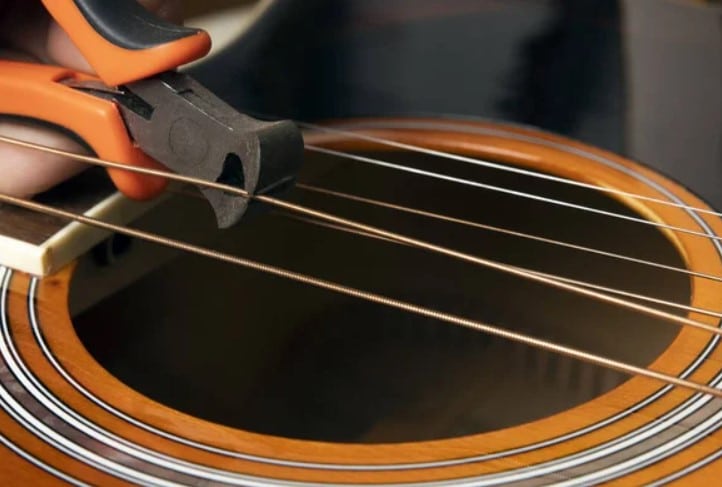
Can Guitar Strings Break When You’re Not Playing?
Yes, bass, acoustic, or electric guitar strings break even when you’re not playing.
This is especially true if the strings are exposed to extreme temperatures or humidity.
If you’re not playing your guitar regularly, storing it in a case or a dry environment is a good idea to reduce the risk of string breakage
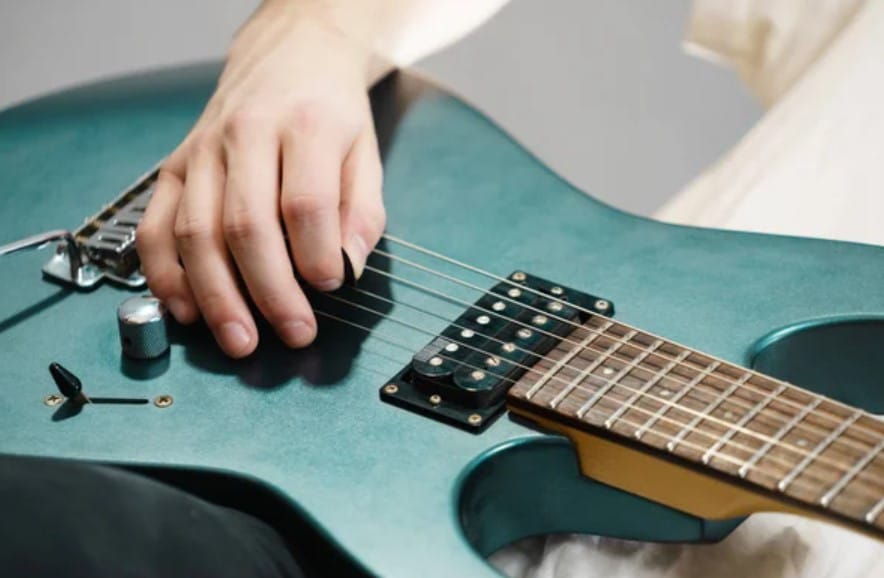
Choosing the Right Guitar Strings
Let’s go through the process of selecting the perfect set of strings, that match your playing style and preferences.
Step 1: Determine Your Playing Style
Before choosing new guitar strings though, it’s essential to identify your playing style. Are you a beginner or an experienced guitarist? Do you play acoustic or electric guitars? Are you more into rhythm or lead playing?
By answering these questions, you can effectively refine your guitar setup options and discover the guitar strings that best cater to your requirements.
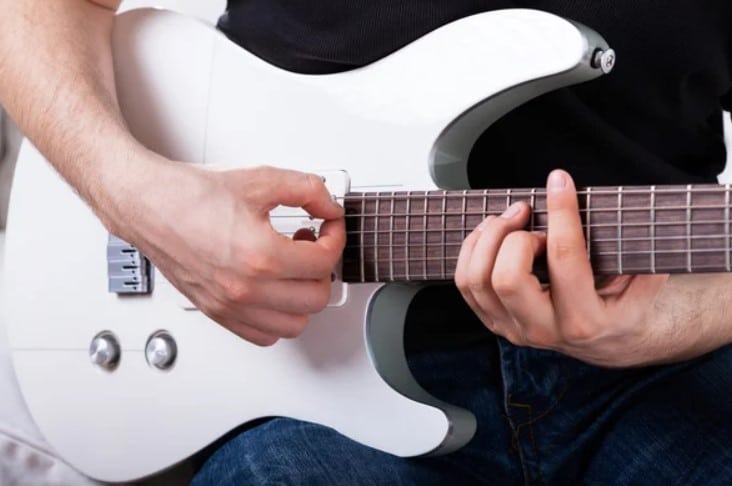
Step 2: Decide on String Gauge
String gauge refers to the thickness of the strings. Strings with a lighter gauge are more pliable and flexible, making them ideal for novices and individuals who prefer a gentler touch while playing.
Medium gauge strings provide a good balance between playability and tone,
While heavier gauge strings produce a richer tone and are preferred by experienced players or those who play in lower tunings. Consider your playing style and strength when selecting the appropriate gauge.
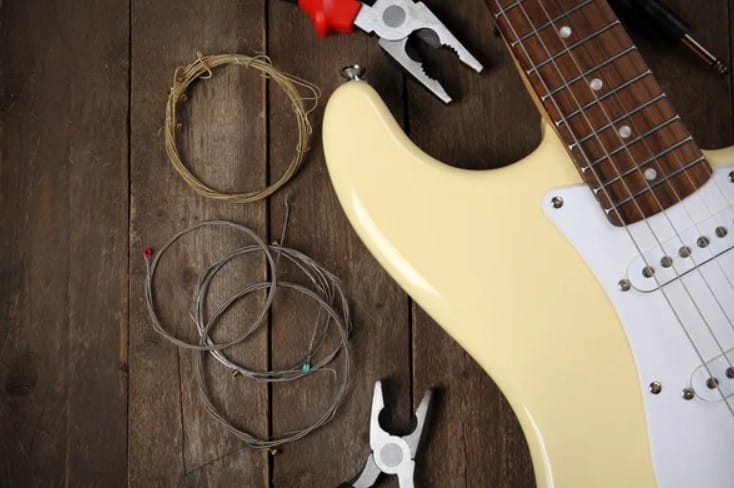
Step 3: Choose the Right Material
Guitar strings come in various materials, each with unique tones and characteristics. The most common options are:
Nickel-plated Steel: Versatile, and a great choice for all music styles.
Stainless Steel: Offer a brighter tone and increased durability.
Pure Nickel: Ideal for vintage tones and warm, smooth sound.
Phosphor Bronze: Preferred for acoustic guitars, they provide a warm and balanced tone.
Experimenting with different techniques and materials can help you discover your preferred sound.
Step 4: Consider Coated or Uncoated Strings
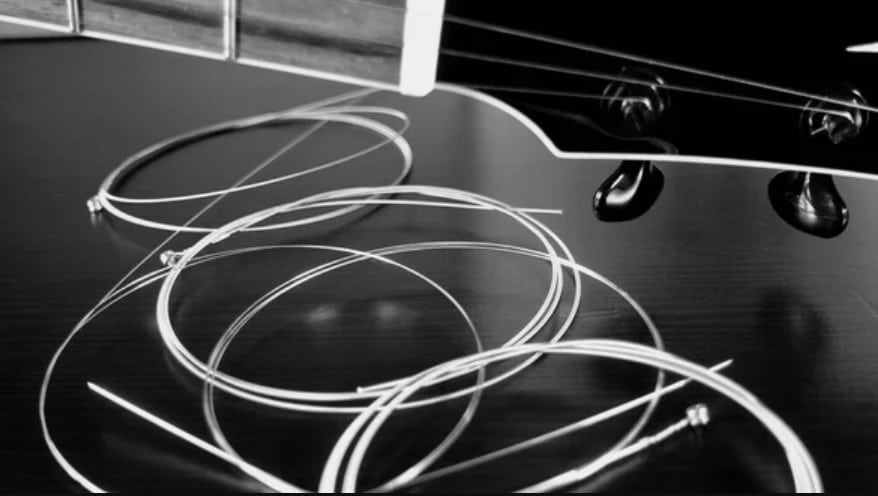
Coated strings have a protective layer that helps prevent dirt, grime, and moisture from building up, extending their lifespan.
While coated strings tend to last longer, they may slightly affect the feel and tone. Uncoated strings provide a more natural sound but may corrode more quickly.
If longevity is a priority in string life for you, consider coated strings.
Step 5: Try Different Brands
Different string brands can offer various tones, durability, and playability.
Don’t hesitate to try out several brands within your preferred specifications to find the one that suits you best.
Ask your fellow guitarists, consult reviews, or seek advice from music professionals for recommendations.
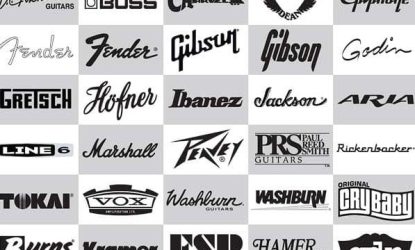
Step 6: Experiment and Trust Your Ears
Choosing the right strings is personal, and there’s no one-size-fits-all approach.
While the guidelines above can point you in the right direction, it’s crucial to trust your ears and experiment.
Play different guitars and styles with various string sets until you find your perfect match.

Our Recommended Guitar Strings
Martin M140 Bronze

FEATURES: -Made with bronze material
-High-quality construction
-Light gauge for easy playability
- Excellent tone and projection
- Durable and long-lasting
- May require frequent tuning
- Not suitable for players who prefer heavy gauge strings
When you click ‘Check Price’, you’ll see there are loads of great places to buy this item. Our personal favorite is Sweetwater for the US, and Thomann and Gear4Music for the UK & Europe.
They are the largest music retailers, with excellent customer service, competitive prices, really fast shipping, and the longest guarantees.
The professional musician who wrote this article combined many things,
from the product build, manufacturer’s reputation through to feedback
from other users, to create our famous TedScore™.
Gibson Vintage Reissue

FEATURES: -High-quality construction for superior tone and durability
-Vintage reissue
design for authentic sound and feel
-Perfect balance of tension and flexibility for
comfortable playing
- Rich and warm tone that enhances the overall sound of the guitar
- Excellent sustain and resonance for expressive playing
- Relatively higher price compared to other guitar string brands
- Limited availability in certain regions or stores
When you click ‘Check Price’, you’ll see there are loads of great places to buy this item. Our personal favorite is Sweetwater for the US, and Thomann and Gear4Music for the UK & Europe.
They are the largest music retailers, with excellent customer service, competitive prices, really fast shipping, and the longest guarantees.
The professional musician who wrote this article combined many things,
from the product build, manufacturer’s reputation through to feedback
from other users, to create our famous TedScore™.
Rotosound Tru Bass 88

FEATURES: -Designed for electric bass guitars
-Made of stainless steel for durability
-Produces deep and punchy tones
- Excellent sustain
- Versatile sound for various musical styles
- Can be slightly more expensive than other strings
- May take some time to break in and settle into desired tone
When you click ‘Check Price’, you’ll see there are loads of great places to buy this item. Our personal favorite is Sweetwater for the US, and Thomann and Gear4Music for the UK & Europe.
They are the largest music retailers, with excellent customer service, competitive prices, really fast shipping, and the longest guarantees.
The professional musician who wrote this article combined many things,
from the product build, manufacturer’s reputation through to feedback
from other users, to create our famous TedScore™.
Ernie Ball 2233 Super Slinky

FEATURES: -High-quality nickel-plated steel strings
-Light gauge (.009-.042),
perfect for comfortable playing
-Bright and balanced
tone for different playing styles
- Great durability, suitable for regular use
- Easy string bending and fretting due to the light gauge
- May produce less sustain compared to medium or heavy gauge strings
- May require more frequent restringing due to the lighter gauge
When you click ‘Check Price’, you’ll see there are loads of great places to buy this item. Our personal favorite is Sweetwater for the US, and Thomann and Gear4Music for the UK & Europe.
They are the largest music retailers, with excellent customer service, competitive prices, really fast shipping, and the longest guarantees.
The professional musician who wrote this article combined many things,
from the product build, manufacturer’s reputation through to feedback
from other users, to create our famous TedScore™.
D'Addario EJ45 Pro-Arte Nylon, Normal Tension

String Tension Rating: Normal
FEATURES:-Semi-polished bass strings
offer rich low end with minimal fret noise
- Reliable classical tone - D'Addario's best-selling, normal tension set
- Superb treble string intonation and consistency from laser-controlled production
- Long-lasting and great for the planet, with eco-friendly, anti-corrosion packaging
- None
When you click ‘Check Price’, you’ll see there are loads of great places to buy this item. Our personal favorite is Sweetwater for the US, and Thomann and Gear4Music for the UK & Europe.
They are the largest music retailers, with excellent customer service, competitive prices, really fast shipping, and the longest guarantees.
The professional musician who wrote this article combined many things,
from the product build, manufacturer’s reputation through to feedback
from other users, to create our famous TedScore™.
Preventing Guitar String Breakage
As a guitarist, you know how frustrating it can be when your guitar strings start to break in the middle of a performance or practice session.
Fortunately, there are several things you can do to prevent this from happening.
1. Keep Your Guitar Clean
Dirt buildup on your guitar’s strings can cause them to break , more easily.
Make sure to clean your guitar regularly, especially the strings.
You can use a string cleaner or wipe them down with a soft cloth after each use.
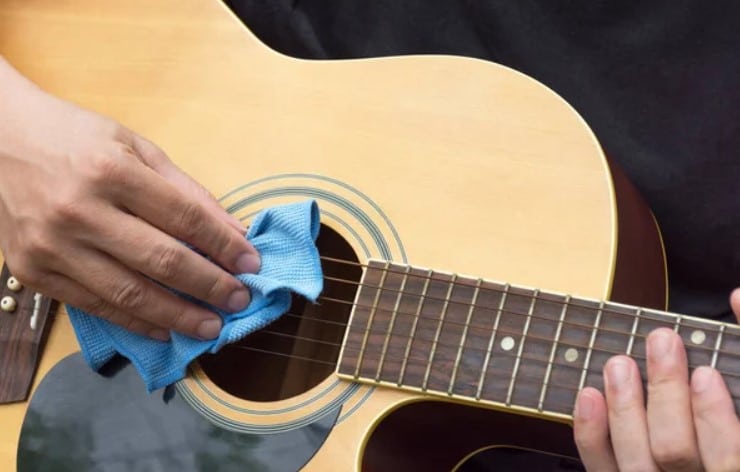
2. Perform Regular Maintenance
Regular maintenance can help prevent string breakage. Check your guitar’s tuning stability and make any necessary adjustments.
Use a file or sandpaper to smooth out any burred or sharp edges on the tuning posts or nut.
This will help prevent the strings from breaking through these areas.
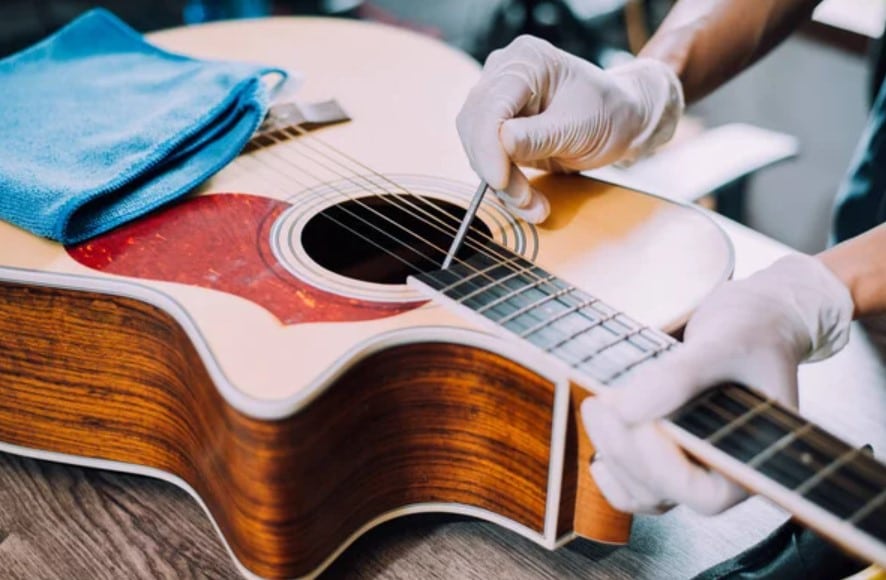
3. Change Your Strings Regularly
Old, worn-out strings are more likely to break than new ones.
Make sure to change your strings regularly, especially if you play frequently.
It’s a good idea to keep a few spare sets on hand so you can change them as soon as they wear out.
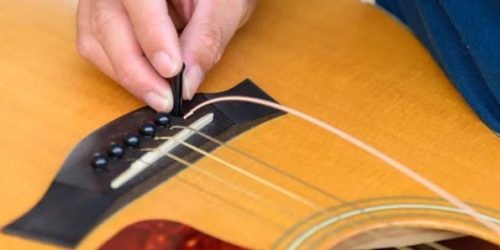
4. Use Coated Strings
Coated strings are less likely to break than uncoated ones.
They have a thin layer of coating that helps protect them from dirt and other debris.
While they may be slightly more expensive, they can be worth the investment if you’re tired of constantly replacing broken strings.
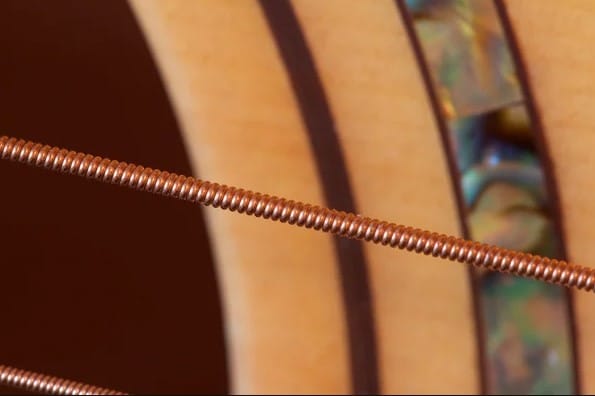
When to Change Guitar Strings
For you to enjoy playing the guitar properly for as long as possible, you need to learn ways to prevent a string break.
So, you need to know when to change your guitar strings. Old strings can cause your guitar to sound dull and lifeless. Changing your guitar strings is essential to keep your guitar sounding its best.
But how often should you change your guitar strings? Well, the answer depends on how often you play guitar and how much you sweat.
You may need to change your strings monthly if you play your guitar daily and sweat a lot.
On the other hand, if you only play occasionally, you may get away with changing your strings every six months.
Another factor to consider is the age of your strings. Even if you don’t play your guitar often, old strings can still lose their brightness and tone over time.
Changing your guitar strings at least once a year is recommended to keep them fresh and sounding their best.
So, how do you know when to change your guitar strings? Here are some signs to look out for:
Dull sound: If your guitar sounds dull and lifeless, it indicates that your strings are old and need to be changed.
Rust or discoloration: If you notice rust or discolouration on your strings, it’s a sign that they are old and need to be changed.
Difficulty tuning: If you find it difficult to tune your guitar, it could be because your strings are old and worn out.
Dealing with Broken Guitar Strings
It’s always frustrating when you’re in the middle of a jam session or a gig, and your guitar string breaks. But don’t worry, it happens to the best of us.
Here are some tips for dealing with broken guitar strings:
Have a backup guitar: If you’re a professional musician, it’s always a good idea to have a backup guitar handy. If a string breaks, you can quickly switch to your backup guitar and keep playing.
Replace the broken string: If you don’t have a backup guitar, you’ll need to replace the broken string. Make sure you have some spare strings, and take the time to replace the broken string. It’s important to note that if you’re using heavier gauge strings, they may be more prone to breaking.
Check for buzz: After you’ve replaced the broken string, check for any buzzing sounds. Buzzing can be caused by various factors, including a loose or worn fret, or a poorly adjusted bridge. If you’re unsure what’s causing the buzzing, take your guitar to a professional for a tune-up.
Tune your guitar: After you’ve replaced the broken string, make sure you tune your guitar. Even if you’re using the same gauge and type of string, the new string may not be in tune with the other strings.
Check the ball end: When replacing a broken string, ensure you check the ball end. The ball end is the string part that goes into the bridge. If the ball end is damaged or worn, it can cause the string to break more easily.
Consider wound strings: If you’re having trouble with guitar strings breaking, consider using wound strings. Wound strings have a metal core with a wrap of wire around it. This makes them stronger and less prone to breaking.
Remember, broken guitar strings are a common problem, but with a little preparation and know-how, you can quickly get back to playing your favorite tunes.
How Often Do Guitar Strings Break
A Recap
Guitar strings can last for varying lengths, depending on several factors. The frequency of playing, the intensity of playing, and the quality of the strings all play a role in how often guitar strings break.
Changing guitar strings every 3-6 months is generally recommended, but this can vary depending on the factors mentioned above.
You may need to change your strings more often if you play frequently or with more intensity. On the other hand, if you play less frequently or with less intensity, your strings may last longer.
It’s also important to note that the type of guitar strings you use can affect their durability. Higher-quality strings may last longer, while lower-quality strings may break more easily.
It’s also important to take care of your guitar strings by keeping them clean and protected from moisture and other environmental factors.
This can help prolong their lifespan and prevent them from breaking prematurely.
Ultimately, the key to keeping your guitar strings from breaking too often is to find a balance between playing frequency and intensity, using high-quality strings, and taking good care of them.
Wait, there’s more!!!
Want more guitar string recommendations? Jump into the next article to discover the 20 Best Guitar Strings that will surely level up your strumming!
FAQ's
Yes, it’s common for guitar strings to break due to wear and tear from playing and changes in temperature and humidity. However, proper maintenance and regular string changes can help prevent frequent string breakage.
Guitar strings typically last for several weeks to a few months, depending on how often they’re played, the type of strings, and the player’s technique. Changing them every 1-3 months is recommended for optimal sound and playability.
The high E string is the most common string to break on a guitar due to its thin gauge and high tension. It’s also the string that is most frequently played, which can contribute to its wear and tear.
Acoustic guitar strings break depending on several factors, including the type of strings, how frequently they are played, and how well they’re maintained.
Generally, acoustic strings can last from a few weeks to several months before they break.
Bass guitar strings break relatively easily, especially if they’re old or have been played frequently. However, proper maintenance and handling can help prevent bass guitar strings from breaking prematurely.












About string breakage – I think you missed pointing out the role of the guitar’s nut and saddle condition. Rough spots or burrs on either can frequently lead to breaks. It’s not just about the strings’ quality or how often you’re changing them, but also ensuring that the guitar itself is properly maintained and doesn’t contribute to the problem. Anyone has thoughts on this or a different experience?
back in my day, we didn’t have much choice in guitar strings, you just played what you could get your hands on. it’s amazing seeing all these options now, materials, coatings, all that. It’s great for the new generation to dial in their sound precisely how they want, but also a bit overwhelming i guess. i remember when breaking a string mid-show meant you were in for a rough time, nowadays, seems like strings can last ages if you take care of them right. good on you for putting this info out there, helps keep the music alive and kicking.
Regarding the section on breaking guitar strings, I think there’s an oversimplification. While it’s true that strings can break from wear and age, the role of technique shouldn’t be underestimated. Aggressive strumming or bending without proper technique can lead to more frequent breaks. It’s not just about the strings’ lifespan but also how they’re treated. Would love to see more on this, Hugh Richardson.
Good point! Noticed my strings last longer when I eased up a bit on the bending.
Breaking strings freaks me out every time. Glad it’s not just a me problem lol.
breaking strings sux. happens all the time. gotta keep extras handy.
Solid advice on preventing breakage. Cheers!
Loved the bit about preventing string breakage. I never really thought about the impact of keeping your guitar clean on the lifespan of the strings. Gonna start cleaning it more often, thanks for the tip!
Seriously? You just figured out cleaning your guitar is important? That’s guitar care 101, buddy.
In the article, it mentions coated strings. What exactly are the benefits of using coated versus uncoated strings? New to all this and trying to absorb as much info as possible. Thanks!
I found the discussion on coated vs. uncoated strings interesting, Hugh Richardson. However, it seems you didn’t consider how different coatings can affect the sustain and overall tonality of the guitar. While coated strings last longer, they can sometimes dampen the sound too much for those looking for a brighter tone. It’s a compromise worth mentioning.
Hey Hugh Richardson, I’ve been going through a bunch of your articles, and this one really caught my eye. I’ve always been curious about the effect of string gauge on playing style. You’ve got steps on choosing the right guitar strings, but could you dive a bit deeper into how different gauges impact the guitar’s playability and tone? I’m aiming to get a clearer picture before I make my next string purchase. Thanks a bunch!